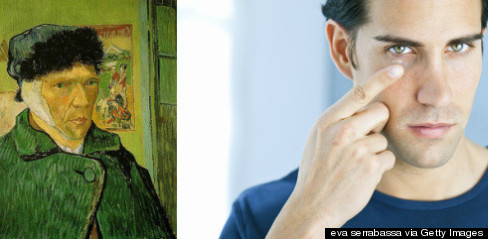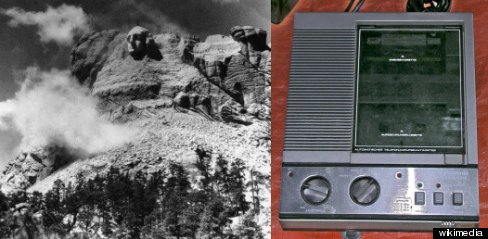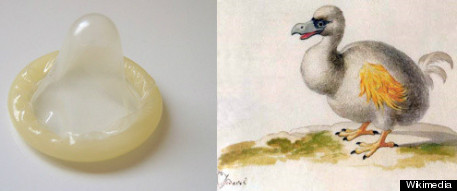There are some historical facts you just know without having to fire up your smartphone. Ice cream? Clearly came after refrigeration. The digital camera? Easy -- that was around the time "Friends" was on the air. The condom? After latex, duh.
Sorry to break it to you, but you're off by a few hundred (or, in some cases, thousand) years. We partnered with Christopher Nolan's Interstellar, in theaters and IMAX on November 7th, to find those amazing inventions that came so early it almost seems wrong. Let's just say, the pace of human ingenuity will make you say, "whoa."
Ice cream: older than sin.
Although the exact dates are murky, many scholars claim that the first books of the Torah were written around 1280 BCE. The relative ingénues of sacred religious texts, the Bible and the Quran, were written as early as the 1st century CE and 7th century CE, respectively.
But ice cream may have beaten Moses down the mountain -- by a millennium or two. It's contentious (who wouldn't want to claim they created ice cream?), but some food historians date the innovation of ice cream back to China around 3000 - 2000 BCE. Early ice cream variations included snow mixed with syrup, and a delicious-sounding concoction of frozen milk and mushy rice. The consensus is that the dessert also popped up in Persia and pockets of the Middle East before the common era.
So if your love for ice cream feels sinful, just remember: ice cream was around before anyone said anything about sin.
Carbonation was around during Benjamin Franklin's heyday.
Beer drinkers lament: Ben Franklin’s famous quote that beer proves that God loves us is actually about wine. While it’s unknown how the founding father felt about gin and tonics, we suspect he’d enjoy them. In 1767, the glorious year that carbonation made the G&T possible, Franklin was serving as a Pennsylvania representative to the British Parliament, predicting the American Revolution in letters and partying with French royalty.
That same year, Scottis chemist Joseph Priestley infused carbon dioxide into water by suspending a bowl of it over a beer vat. He later expanded on his experiment in 1772’s “Impregnating Water with Fixed Air,” although he never quite grasped the commercial applications of his discovery of carbonation. (A German named Schweppe did, however). The revolutionary Priestley later fled England for Franklin’s Pennsylvania, and the two were known friends -- so maybe they had a happy hour after all.
When the parachute was invented, America was only three months old. 
It would make sense for parachutes to come after the airplane, right? But no. NOTHING makes sense anymore.
In September of 1783, the fledgling U.S. and Great Britain signed the Treaty of Paris, which ended the Revolutionary War. Three months later, and several hundred miles to the south, French physicist Louis-Sebastien Lenormand stepped off the top of the Montepellier observatory clutching onto a 14-foot wood and linen parachute. He floated safely to the ground, putting into practice a design birthed by Leonardo da Vinci in 1485. Throughout the next decade, parachute testers dropped -- usually safely -- from hot-air balloons.
It makes you wonder: would things have been different if the Redcoats had paratroopers?
Vincent van Gogh was still alive (and had both ears) when the first pair of contact lenses was crafted. 
In 1888, van Gogh enjoyed one of his most creative periods in Arles -- the French town where he finished painting his famous sunflowers. And, until just before Christmas, when a disturbed van Gogh (probably) turned a knife on himself after a fight with artist Paul Gauguin, both ears remained intact.
Earlier that year in neighboring Switzerland, a German ophthalmologist named Adolf Eugen Flick created something that sounds nearly as painful as losing an ear -- the all-glass contact lens. After a few years of experiments on the eyeballs of rabbits and cadavers, Flick became the first to fit a human with contacts. However, because it was made of glass and covered most of a patient’s eye, it could only be worn for a few hours at a time before a lack of oxygen made the wearer's vision foggy and full of blurred halos.
You couldn't pay us enough to try it out, but we imagine it might make the world look a bit like a (painful and irritated) version of "Starry, Starry Night."
The answering machine was invented when there was still only one President’s head on Mt. Rushmore.
1936 was a busy year. Hitler and Mussolini invaded and annexed the Rhineland and Ethiopia; the first issue of Life Magazine was published; and President Franklin D. Roosevelt attended a dedication ceremony for Thomas Jefferson’s giant head.
That year also saw the sale of what may be the first commercially successful automatic answering machine. The idea, however, had been around much longer: As early as 1924, magazine ads promised a "Telephone and Answering Machine" that was "similar to those used in dictating or talking machines."
In 1934, an engineer at Bell Labs developed a six-foot device that used magnetic tape to record incoming calls. It was innovative, but not well-received. AT&T and Bell feared that being recorded would scare people away from telephones altogether, and squashed the development. A (braver) Swiss company brought a very similar device to market in 1936.
Of course, it would take another 61 years for George Costanza to perfect the device’s use. Mr. Costanza's addition to Mt. Rushmore is, as of writing, not under consideration.
Condoms were around in the time of the Dodo.
The poor, flightless dodo – aka the banner bird for extinct species – was only discovered in the 1590s, when sailors alighted on the island of Mauritius. The last widely-accepted sighting occurred just 70 years later, in 1662. Yes, within a century, humans had wiped out the bird -- either through hunting, or by the introduction of pigs and rats into the dodo's environment.
Far from the Indian Ocean, humanity was attempting to wipe out something else: syphilis. The disease, incurable at the time, ravaged Europe. (It was probably brought back by sailors then exploring the world.) In the 16th century, an Italian physician named Gabriele Fallopius penned a treatise that suggested a method of prevention: a sheath of linen that should be treated in a chemical solution, left to dry and then worn during sexual intercourse. Fallopius' breakthrough may have been a reinvention of an ancient Egyptian idea.
Around the same time that the last dodo was leaving the world, the word "condon" popped into existence -- in a report fretting over declining English birthrates.
The English were, at least, doing better than the dodo.
Kodak engineers built the first digital camera the same year as the fall of Saigon.
Children of the 1990s will remember the slow transition from the boxy, yellow disposable cameras to fancy digital ones. But digital was already around for a long time beforehand.
In 1975, South Vietnamese forces, fighting without the U.S. military, crumbled under a North Vietnamese onslaught. A Dutch cameraman captured the chaos as South Vietnamese citizens scrambled to get aboard American helicopters.
In far calmer settings, Eastman Kodak engineer Steve Sasson crafted the world’s first digital camera out of spare movie camera parts, cassette tapes and a black and white television. It probably wouldn't have served much use in wartime. Weighing in at eight pounds, the .01 megapixel camera took 23 seconds to process a photo.
Also weighing in that year: Muhammad Ali, at 224.5 pounds, for the Thrilla in Manila. We're guessing that the champ was also too quick for the first digital camera.
Any other inventions blowing your mind? Let us know in the comments.
Correction: A previous version of this post misidentified the island of Mauritius as "Mauritania."